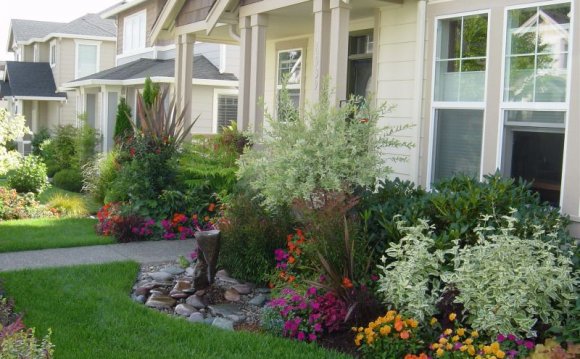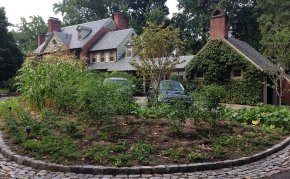
 One of the first landscaping changes we made upon moving into our new house last year was getting rid of several sprawling, weed-ridden mounds of winter jasmine that were choking the life out of all the plants in our front yard. We covered the dirt with mulch and then turned our attention to planning a vegetable and herb garden for the backyard.
One of the first landscaping changes we made upon moving into our new house last year was getting rid of several sprawling, weed-ridden mounds of winter jasmine that were choking the life out of all the plants in our front yard. We covered the dirt with mulch and then turned our attention to planning a vegetable and herb garden for the backyard.
As we were getting ready to break ground for the new beds, inspiration struck. Why not put the garden out front, in the area we had just cleared?
My husband, who is not known for his sense of adventure, balked. What would people think? Cornstalks and watermelon vines in the front yard aren’t exactly de rigueur in our new neighborhood. I’m no rebel myself but had come to realize that our new backyard was not ideal for the mini-farm of our dreams. All those gorgeous trees we fell in love with at the open house provide excellent shade and privacy, but would compete with vegetables for water and sunlight. Then there is the matter of the slope, which makes for excellent sledding but not such great plant growing. Our front yard, on the other hand, is flat and wide open. There is no ordinance where we live that prohibits growing food in front yards, so why let all that glorious sunshine go to waste? And well, that front bed is fully irrigated.
Six months later, our front yard garden is a blooming success, and we’re planning another for next year. Here’s why you may want to try one, too.
1. Aesthetics
While traditionalists may give you the stink-eye for deviating from the standard front yard fare of boxwoods and azaleas, there’s no denying that a thoughtfully arranged array of blooming squash plants, tasselling corn and purple basil are a feast for the eyes. And then there are all those gorgeous smells. In our garden, the basil, thyme and cilantro are situated right next to where I park my car. I don’t encourage my children to trample the plants while wrestling backpacks and skateboards out of the back seat, but the tumult often releases a heavenly fragrance.
2. No more “out of sight, out of mind” mentality
With the vegetables physically located in your daily line of sight, garden chores are less likely to accumulate into overwhelming, weekend-killers. On the way to and from the mailbox, it’s a simple matter of yanking a few weeds or straightening out those seedlings that the neighbor’s free-range cat knocked over.
Then, there’s the ease of enjoying the fruits of your labor. Even if you love cooking with fresh vegetables, it can be a bother trudging out back to figure out what’s ready to be cooked each night. With the garden out front, your tomatoes, zucchini and beets will be staring you in the eye as you pull in and out of the driveway every day. (Sometimes, it feels like ours are daring me to order a pizza or pick up a pre-made salad.)
I’ve also appreciated how the high-visibility location has helped us enjoy our garden more. We can’t help but notice and marvel at the changes taking place every day and sometimes even throughout the day.
3. Critters
Vegetables and herbs present a hospitable environment for productive visitors such as butterflies, bees and earthworms. The traditional floral components of our front landscape undoubtedly benefit from all these happy and busy, critters. And, they mostly have the place to themselves. The squirrels, rabbits and deer who find our yard so inviting seem to prefer the back where there is plenty of cover and no traffic, which is one more plus in the front yard garden column.
4. Conversation Piece
If you have corn growing on your front lawn, I guarantee you that every person who comes to your door will have something to say about it. Happily, in our case, all the comments so far have been glowing. And what a great conversation starter to meet strangers passing down the street: “Hi, you look like you could use some squash!”
If you are looking for a way to breathe new life into your gardening routine, a front yard vegetable and herb garden is worth considering. Not ready to commit? Sprinkle a few lettuce seeds where you usually plant your annuals. See how you like the effect. If nothing else, a little crop rotation is always a good for your soil — and soul.
Traffic stats














